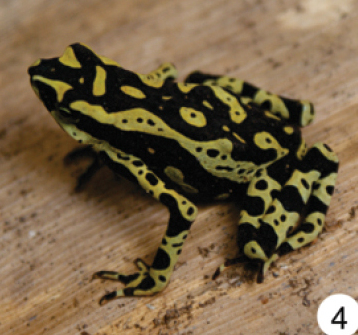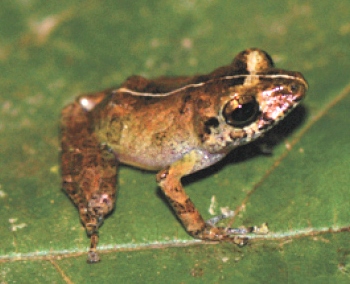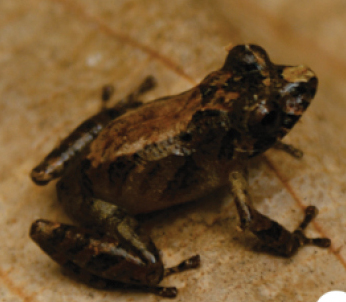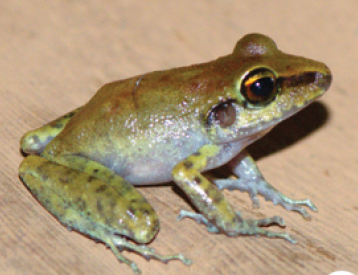Discovering Pristimantis hoogmoedi: The Enigmatic Frog of the Andes#
Amidst the verdant canopies and chattering streams of the Ecuadorian Andes lies a hidden gem of biodiversity — the extraordinary frog known scientifically as Pristimantis hoogmoedi. This remarkable amphibian is not just another member of the frog family; it is a testament to the complexities and wonders of tropical ecosystems. With its vibrant coloration and distinctive behaviors, P. hoogmoedi captivates enthusiasts and scientists alike, illustrating the intricate interdependence of life in its habitat. Intrigued? Prepare to leap into the world of this stunning species, where each croak and splash tells a story of survival and adaptation.
Taxonomy and Classification#
To unlock the mysteries of Pristimantis hoogmoedi, we first need to delve into its taxonomic roots. This species belongs to the family Craugastoridae, commonly known as the rain frogs or land frogs, which are characterized by their terrestrial adaptations. Within its genus, Pristimantis, there exists a diversity of species, many of which are endemic to the rich environments of Central and South America. The significance of this classification lies not only in the naming of the species but also in understanding its evolutionary journey and relationships with closely related frogs, underscoring the vast tapestry of life that inhabits the Andean region.
Natural Habitat#
Pristimantis hoogmoedi is primarily found within the lush landscapes of the Andean cloud forests of Ecuador. This region is characterized by its high humidity, cool temperatures, and rich biodiversity, making it a sanctuary for countless organisms. The frog thrives in the understory and leaf litter of these forests, where it can easily blend into the mosaic of fallen leaves and twigs. Its preference for these moist environments facilitates access to a myriad of small invertebrates that constitute its diet.
As the mist swirls through the forest, creating an ethereal atmosphere, the interactions between P. hoogmoedi and its ecosystem unfold. This frog plays a critical role in controlling insect populations, ensuring the delicate balance of its habitat remains intact. Its presence signals a healthy environment, as it relies on clean water sources and stable temperatures to thrive, making it an important indicator species for conservationists.
Physical Characteristics#
The physical appearance of Pristimantis hoogmoedi is as extraordinary as its habitat. Adult frogs typically measure about 2.5 to 4 centimeters in length, featuring a robust body that enhances their ability to navigate through dense foliage. Their skin exhibits a fascinating palette of colors, often showcasing vibrant greens and earthy browns, adorned with intricate patterns that provide camouflage against predators. The dorsal surfaces are frequently textured with tubercles, or small bumps, which serve not only to break up their silhouette but may also play a role in moisture retention within the humid habitat.
Interestingly, some adaptations of P. hoogmoedi extend beyond mere aesthetics. Many individuals possess granular skin which may produce toxic secretions—defense mechanisms against potential predators such as birds and snakes. This evolutionary trait highlights the ongoing arms race between prey and predator in the natural world, where survival often hinges on subtle adaptations.
Behavior and Life Cycle#
Pristimantis hoogmoedi exhibits a range of intriguing behaviors that further its integration within the ecological fabric of the Andean forests. Primarily a nocturnal species, this frog comes alive after the sun dips below the horizon, embarking on nightly foraging excursions in search of small insects, spiders, and other invertebrates. Using its agile limbs, it climbs the underbrush with ease, displaying remarkable agility that allows it to thrive in a three-dimensional world of foliage.
During the breeding season, which coincides with the rainy months, the male frogs can be heard calling out to attract mates. These melodious croaks echo through the rainforest, a symphony of life resonating beneath the emerald canopy. Once a female has chosen her mate, the duo engages in a unique embrace known as amplexus, where the male clings to the female as she lays her eggs. Instead of traditional egg-laying habits that require standing water, P. hoogmoedi prefers to lay its eggs in moist leaf litter, a remarkable adaptation witnessed in many terrestrial frogs. Upon hatching, the tadpoles develop directly into juvenile frogs, avoiding the water stage entirely — a perfect illustration of evolutionary ingenuity amidst a changing climate.
Ecological Role#
In the intricate web of the Andean ecosystem, Pristimantis hoogmoedi plays a multifaceted role as both predator and prey. As a voracious insect-eater, it helps regulate the population of detritivores and other invertebrates, contributing to the health of the forest floor. In turn, the frog serves as a nutritional resource for a variety of predators, including birds and snakes, illustrating the delicate balance that sustains ecological harmony.
This frog also serves as an indicator species, meaning that its presence or absence can provide critical insights into environmental health. A decline in the P. hoogmoedi population may signal broader ecological shifts due to habitat degradation or climate change, emphasizing the need for ongoing monitoring and conservation efforts.
Threats and Conservation Status#
Despite its fascinating adaptations and ecological significance, Pristimantis hoogmoedi faces an uncertain future. The primary threats to its survival stem from habitat loss due to deforestation, agricultural expansion, and climate change, which compromise the delicate balance of its cloud forest habitat. Invasive species and pollution also pose significant risks, potentially devastating local ecosystems that P. hoogmoedi relies on. According to the IUCN Red List, Pristimantis hoogmoedi has been classified as Endangered, underscoring the urgent need for conservation interventions.
Various initiatives are underway to protect P. hoogmoedi and similar species. Habitat restoration efforts focus on reforestation and the establishment of protected areas, allowing frogs and other wildlife to thrive in their natural environments. Research and monitoring are vital components, aiming to gather data on population trends and adapt conservation strategies accordingly.
Cultural and Scientific Significance#
The cultural significance of Pristimantis hoogmoedi extends beyond science and conservation; it is entwined with the rich heritage of the regions it inhabits. Indigenous peoples often share stories and beliefs surrounding local fauna, including frogs, highlighting their importance within the ecosystem and their symbolic meanings, such as transformation and fertility.
From a scientific perspective, this frog species has drawn the attention of researchers not only for its remarkable adaptations but also for the potential biochemical compounds present within its skin. Many amphibians produce unique toxins that have captured the imagination of pharmacologists and ecologists alike, representing a treasure trove of bioactive substances that may hold the key to new medicines. Through continued scientific inquiry, P. hoogmoedi will undoubtedly yield further insights into the interconnection between nature and science.
Conclusion#
As we reflect on the complex life of Pristimantis hoogmoedi, it becomes evident that this fascinating frog is more than just a simple inhabitant of the Andean cloud forests. It embodies the intricate web of life, representing adaptability in the face of adversity and the fragility of hidden ecosystems. By supporting conservation efforts and raising awareness about the importance of amphibians like P. hoogmoedi, we partake in a collective responsibility to ensure their survival for generations to come. Explore, learn, and appreciate the diversity of our natural world — every leap matters in the journey of conservation.
“`

















